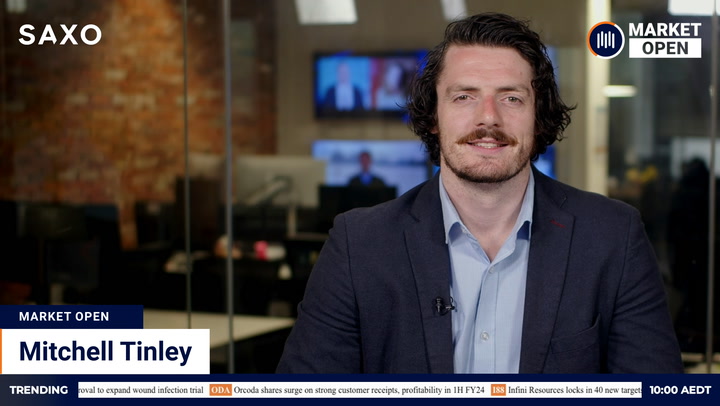Wall Street’s best night since 2020 points to early gains for Australian investors after the Federal Reserve raised its benchmark interest rate by 50 basis points and ruled out larger increases.
ASX futures climbed 31 points or 0.43 per cent as a relief rally swept US stocks higher. Treasury yields declined, easing pressure on beaten-up growth stocks.
The outlook for Australian trade was kept in check by a decline in iron ore and a huge surge in the dollar. The Aussie was lately up more than 2 per cent against a plunging greenback. Oil and most metals rallied.
Wall Street
US stocks soared after the Fed announced a widely-anticipated rate hike while soothing the market’s worst fears about the outlook for future increases.
The S&P 500 surged 127 points or 2.99 per cent. The Dow Jones Industrial Average rallied 932 points or 2.81 per cent. The Nasdaq Composite gained 401 points or 3.19 per cent.
The central bank raised the federal funds rate target by 50 basis points to 0.75 – 1 per cent. The increase was the second this year amid a surge in inflation to a four-decade high.
Stocks initially wobbled before kicking higher after Chair Jerome Powell ruled out increasing by 75 basis points at future meetings.
“A 75 basis point increase is not something that committee is actively considering,” Powell said. “I think expectations are that we’ll start to see inflation, you know, flattening out.”
Last night’s 50 basis points hike was the largest since 2000, but had been widely telegraphed. Powell indicated further 50 basis point hike were on the table for the “next couple of meetings”. The bank also announced plans to trim down a balance sheet bloated by stimulus spending.
The relief rally continued a turbulent run for US equities as investors price in a range of risks, including increased borrowing costs, surging inflation, supply-chain issues, a war in Ukraine and Covid lockdowns in China. The Nasdaq Composite began this week in a bear market. The S&P 500 and Dow were in technical corrections.
Kim Forrest, founder of Bokeh Capital, told CNBC the Fed ruling out bumper hikes of 75 basis points took some of the fear out of the market.
“I think taking that off the table, you know, was wise and is probably cause for some of the relief,” he said.
All 30 Dow component companies rose. The Russell 2000 index of small caps gained 2.69 per cent. The VIX or volatility index dived 13 per cent.
Bank stocks were boosted by early strength in treasury yields and remained strong even as yields backed off their highs.
Australian outlook
A strong start coming up after a powerful relief rally swept Wall Street. The Federal Reserve pulled off a neat conjuring trick by raising rates substantially without spooking the market.
“We’re still going to get a lot of Fed hikes. Just not as many as markets had priced in. Money markets were pricing in a more aggressive trajectory than the Fed hinted at today which led to an inevitable repricing,” City Index senior market analyst Matt Simpson said.
The S&P/ASX 200 is coming off the back of a three-session losing run as the first rate increase here in 12 years takes some of the froth out of the market. The tremors were particularly strong yesterday at the speculative end of the market. While the broader ASX 200 fell a mild 0.16 per cent, the Emerging Companies Index tanked 2.35 per cent.
The outlook for the day ahead has been tempered by an extreme move in the dollar. The Aussie flew up 2.21 per cent from around 71 US cents to 72.57 cents as the greenback deflated.
“The US dollar index fell around -1% during its second worst session this year, and the Australian dollar enjoyed its best day since the pandemic,” Simpson said.
A strong dollar is broadly negative for the Australian economy because it makes exports more expensive for holders of other currencies. (Importers obviously benefit from greater spending power.) Dollar gains also tempt overseas stock investors to lock in easy profits from currency movements.
All 11 US sectors advanced. Energy was the standout, climbing 4.12 per cent as oil traders applauded a European Union proposal to phase out Russian crude imports.
Tech gained 3.51 per cent. The ASX’s most heavily-weighted sectors, materials and financials, both put on more than 3 per cent.
Defensive sectors, including real estate and consumer staples, brought up the rear but still saw gains of at least 1.1 per cent.
NAB releases half-year results today. Rio Tinto, QBE, Iress and Ventia Services Group hold annual general meetings.
Monthly reports on trade and building approvals were scheduled for 11.30 am AEST. China releases a services-sector PMI 15 minutes later.
Commodities
Oil jumped almost 5 per cent on European Union plans to embargo Russian oil. EU President Ursula von der Leyen called on the bloc’s 27 countries to halt crude imports within six months and refined products by year-end.
The proposal would require the backing of all 27 member states. Von der Leyen conceded that winning support for the measure “will not be easy”.
Brent crude settled US$5.17 or 4.9 per cent higher at US$110.14 a barrel. The US benchmark jumped 5.3 per cent to US$107.81.
Gold dipped in regular trade before recovering strongly after the Fed’s rates outlook pulled the rug from under the US dollar. Metal for June delivery was lately up US$11.70 or 0.6 per cent at US$1,882.30 an ounce after earlier settling US$1.80 or 0.1 per cent lower at US$1,868.80. The NYSE Arca Gold Bugs Index rose 1.02 per cent.
“The dollar index has lost steam on the back of the Fed’s decision and this has helped the gold price which has been oversold as some were thinking that the Fed may increase the interest rate by 75 basis points,” Naeem Aslam, chief market analyst at AvaTrade, wrote.
Most industrial metals reversed some of this week’s heavy falls. Benchmark copper on the London Metal Exchange bounced 0.7 per cent to US$9,468 a tonne. Aluminium gained 1.5 per cent, lead 1.4 per cent and tin 0.9 per cent. Nickel fell 1.2 per cent and zinc lost 0.1 per cent.
Iron ore slid in thin trade as holidays kept many Chinese buyers away. The spot price for ore landed in northern China declined 76 US cents or 0.5 per cent to US$142.80 a tonne.
“With Chinese participants absent on May 1-4 for the Labor Day holiday, trading activity has been very limited so far this week, further depressing demand,” Fastmarkets noted.
Mining giants BHP and Rio Tinto recovered in US trade after falling in the UK. BHP‘s US-traded depositary receipts gained 2.05 per cent. Earlier, the miner’s UK listing fell 2.31 per cent. Rio Tinto put on 0.97 per cent in the US and lost 2.71 per cent in the UK.





